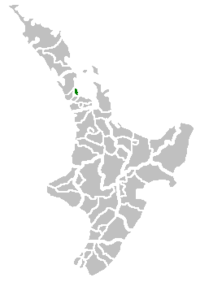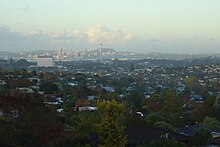North Shore, New Zealand
| North Shore | ||
|---|---|---|
 | ||
| Territorial Authority |
Name | North Shore City |
| Population | 205,605[1] | |
| Land area | 129.81 km² (50.12 sq mi) | |
| Density | 1,583.89/km² | |
| Regional Council |
Name | Auckland |

North Shore City (usually informally the North Shore, or sometimes just The Shore) is a city in the Auckland region of New Zealand. At June 2006, the city had a population of 215,300, making it the fourth most populous city in New Zealand. The city is also the country's fourth largest city in land, with an area of 129.81 square kilometres. It is one of four cities in the Auckland metropolitan area. It is the most densely populated city in the country because, unlike other New Zealand cities, most of the city's area is urban or suburban in character.
Geography

North Shore is bounded by Rodney District to the north, Waitemata Harbour to the south and the Rangitoto Channel of the Hauraki Gulf to the east. The Auckland Harbour Bridge connects it to Auckland City on the south side of the Waitemata Harbour, while the Upper Harbour Bridge connects it to Waitakere in the west.
The seat of the North Shore City Council is in Takapuna. The city is divided into three wards, Harbour, Northern and Central, and each ward is further divided into two community boards. Inner suburbs include Milford, Takapuna, Belmont, Devonport, Bayswater, Northcote, Birkenhead, Highbury, Hillcrest, Glenfield, Wairau Valley, Westlake and Forrest Hill. Outer suburbs include Birkdale, Beach Haven, North Harbour, Albany, Greenhithe, Long Bay*, Torbay*, Waiake*, Browns Bay*, Rothesay Bay*, Murrays Bay*, Mairangi Bay*, Campbells Bay* and Castor Bay.
Those here with an asterisk, along with several other minor beaches on the Hauraki Gulf coast, are collectively known as East Coast Bays.
Transport
Commuting within the North Shore itself can be done relatively easily, but those who commute to Auckland City and need to cross the Auckland Harbour Bridge face severe traffic congestion. The alternative route through western suburbs is also prone to nose-to-tail traffic at peak times. As with the greater Auckland area, there has been much discussion regarding the problem at both national and local government levels, but very little concrete action, mostly related to the high cost and difficulty providing additional crossings over the Waitemata Harbour. Several options for new bridges and tunnels have been studied in depth, but at the moment, the official position is to mitigate congestion effects instead of providing new infrastructure.
Public transport has been upgraded in an attempt to reduce the city's car dependence. The Northern Busway along State Highway 1 (to be fully opened in 2009), together with new park and ride facilities in Albany and Constellation Drive (completed in late 2005), is to serve as the spine of a bus-based new rapid transit system for North Shore City and Hibiscus Coast citizens. The North Shore City Council intends to increase the number of these facilities with more park and ride stations in Westlake, Sunnynook and Akoranga park by 2008.[2]
A number of North Shore suburbs have a regular ferry service to Auckland City, including Devonport, Stanley Bay, Bayswater, Birkenhead. Others are planned for Takapuna and Browns Bay.
Local Government
The city is run by a 15 member council (North Shore City Council) and mayor, democratically elected every three years using the First Past The Post voting system. The current mayor is Andrew Williams.
For the purposes of general elections, the city contains three whole electorates, being Northcote, North Shore and East Coast Bays. The electorate of Helensville also takes in portions of the northwest of the city. Politically the city tends to lean to the right: in the 2005 General Election, all four electorate MPs were the National Party candidates.
Economy
There are over 22,000 businesses located in North Shore City, contributing to over 6% of New Zealand's GDP. The city also tops the nation's growth rates for numbers of businesses, growing 29.3% between 1998 and 2002.[3]
The last five years have seen tremendous growth in the Albany area. This once quiet rural suburb has become the commercial centre of the North Shore. A number of retailers like Westfield are building or have built "super stores" in the area, anticipating ongoing commercial growth and expansion. The area has also experienced the construction of intense cheaper housing, and thousands of acres of farmland has been turned into mini-suburbs comprising hundreds of houses all of a similar design. As such, the Albany area has attracted hundreds of millions of investment dollars.
Residential development on the North Shore continues to rapidly sprawl northwards. The Rodney township of Orewa and the Whangaparaoa Peninsula, 25 kilometres north of Takapuna, was once something of a holiday resort. It is now linked by the Northern Motorway and may eventually be continuous with the North Shore's northward urban expansion.
The East Coast Bays boasts some of the most expensive real estate in New Zealand. Running North from Takapuna Beach to Milford, the stretch of coast is often referred to as "the million dollar mile" and many properties there have sold for several million dollars (NZ$) particularly because of the fine beaches, popular schools and shopping centres.
Demographics
In the 2006 census, the median income for North Shore residents over 15 years was $29,100, compared with a national average of $24,400.
The racial makeup of the city was 67.5% European, 18.5% Asian, 6.3% Māori, 3.4% Pacific Islander, and 1.8% from the Middle east, Africa or Latin America. Just under 10% gave their ethnicity as "New Zealander",[1] with most of this group having identified itself as European in former Census surveys.
Notable people
- Frank Sargeson - Writer
- Rachel Hunter - Actress/Model
- Judy Bailey - Retired Newsreader
- Elemeno P - Pop/Rock Band
- Rosita Vai - NZ Idol 2 Winner
- Sir Peter Blake - Yachtsman
- Ian Ferguson - Olympian
- John Hood - Vice-Chancellor of the University of Oxford
- Dean Barker - Yachtsman
- Luke McAlister - Rugby Player
- Ian Jones - Ex All Black Rugby Player
- Bert Sutcliffe - New Zealand Cricketer
- Danny Morrison - New Zealand Cricketer
- Nick Evans - Rugby Player
- Kirk Penney - Basketball Player
References

- ^ a b "QuickStats About North Shore City" (PDF). Statistics New Zealand. 2006.
- ^ "Park & Ride Stations". North Shore City.
- ^ "Growth in the Number of Businesses" (PDF). Quality of Life Project.
External links
- North Shore City Council (official website)
- North Shore City (from Wikitravel project)
- Enterprise North Shore (business association website)
- Takapuna Beach (business association website)
- Webcam over Takapuna (from the official Council website)
